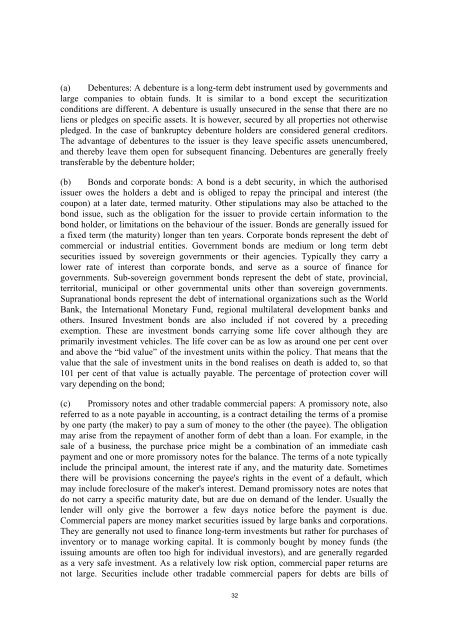taxud/2414/08 - European Commission - Europa
taxud/2414/08 - European Commission - Europa
taxud/2414/08 - European Commission - Europa
You also want an ePaper? Increase the reach of your titles
YUMPU automatically turns print PDFs into web optimized ePapers that Google loves.
(a) Debentures: A debenture is a long-term debt instrument used by governments and<br />
large companies to obtain funds. It is similar to a bond except the securitization<br />
conditions are different. A debenture is usually unsecured in the sense that there are no<br />
liens or pledges on specific assets. It is however, secured by all properties not otherwise<br />
pledged. In the case of bankruptcy debenture holders are considered general creditors.<br />
The advantage of debentures to the issuer is they leave specific assets unencumbered,<br />
and thereby leave them open for subsequent financing. Debentures are generally freely<br />
transferable by the debenture holder;<br />
(b) Bonds and corporate bonds: A bond is a debt security, in which the authorised<br />
issuer owes the holders a debt and is obliged to repay the principal and interest (the<br />
coupon) at a later date, termed maturity. Other stipulations may also be attached to the<br />
bond issue, such as the obligation for the issuer to provide certain information to the<br />
bond holder, or limitations on the behaviour of the issuer. Bonds are generally issued for<br />
a fixed term (the maturity) longer than ten years. Corporate bonds represent the debt of<br />
commercial or industrial entities. Government bonds are medium or long term debt<br />
securities issued by sovereign governments or their agencies. Typically they carry a<br />
lower rate of interest than corporate bonds, and serve as a source of finance for<br />
governments. Sub-sovereign government bonds represent the debt of state, provincial,<br />
territorial, municipal or other governmental units other than sovereign governments.<br />
Supranational bonds represent the debt of international organizations such as the World<br />
Bank, the International Monetary Fund, regional multilateral development banks and<br />
others. Insured Investment bonds are also included if not covered by a preceding<br />
exemption. These are investment bonds carrying some life cover although they are<br />
primarily investment vehicles. The life cover can be as low as around one per cent over<br />
and above the “bid value” of the investment units within the policy. That means that the<br />
value that the sale of investment units in the bond realises on death is added to, so that<br />
101 per cent of that value is actually payable. The percentage of protection cover will<br />
vary depending on the bond;<br />
(c) Promissory notes and other tradable commercial papers: A promissory note, also<br />
referred to as a note payable in accounting, is a contract detailing the terms of a promise<br />
by one party (the maker) to pay a sum of money to the other (the payee). The obligation<br />
may arise from the repayment of another form of debt than a loan. For example, in the<br />
sale of a business, the purchase price might be a combination of an immediate cash<br />
payment and one or more promissory notes for the balance. The terms of a note typically<br />
include the principal amount, the interest rate if any, and the maturity date. Sometimes<br />
there will be provisions concerning the payee's rights in the event of a default, which<br />
may include foreclosure of the maker's interest. Demand promissory notes are notes that<br />
do not carry a specific maturity date, but are due on demand of the lender. Usually the<br />
lender will only give the borrower a few days notice before the payment is due.<br />
Commercial papers are money market securities issued by large banks and corporations.<br />
They are generally not used to finance long-term investments but rather for purchases of<br />
inventory or to manage working capital. It is commonly bought by money funds (the<br />
issuing amounts are often too high for individual investors), and are generally regarded<br />
as a very safe investment. As a relatively low risk option, commercial paper returns are<br />
not large. Securities include other tradable commercial papers for debts are bills of<br />
32
















